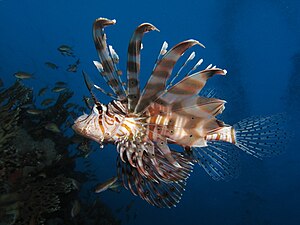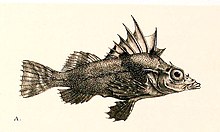Scorpionfish relatives
| Scorpionfish relatives | ||||||||||||
|---|---|---|---|---|---|---|---|---|---|---|---|---|

Indian lionfish ( Pterois miles ) |
||||||||||||
| Systematics | ||||||||||||
|
||||||||||||
| Scientific name | ||||||||||||
| Scorpaenoidei | ||||||||||||
| Garman , 1899 |
The scorpionfish relatives (Scorpaenoidei) are a group of bony fish in the rank of subordination. They live worldwide, especially as neritic coastal fish, in all oceans and are often brightly colored. Many types, e.g. B. the redfish are important food fish, others, like the lionfish , are known as colorful and bizarre coral reef inhabitants. The dragon's head relatives include the stonefish, the most poisonous fish in the world.
Traditionally placed in the polyphyletic order of the armor cheeks (Scorpaeniformes), the Scorpaenoidei were assigned to the perch-like (Perciformes) in a revision of the bony fish system from the beginning of 2013 .
features
Four synapomorphies are given for the scorpaenoidei . These are a single, backward-facing sting on the larvae 's eye socket, a sting on the gill cover , a special muscle on the outside of the swim bladder and an adductor muscle for the dorsal fin . Some of these characteristics also occur in other representatives of the perch-like, including the Cottales .
Other features indicated include strong ossification of the skull, skin ossification, the fusion of the preoperculare with the suborbitalia (bones below the eye socket), large fins and strong fin spines.
Internal system



According to Nelson, Grande and Wilson, the following families and subfamilies belong to the suborder Scorpaenoidei:
-
Scorpionfish (Scorpaenidae)
- Spiked Heads (Sebastinae)
- Setarchinae
- Neosebastinae
- Scorpaeninae
- Fur clumps (Caracanthinae)
- Wasp fish (Apistinae)
- Forehead fins (Tetraroginae)
- Stonefish (Synanceiinae)
- Spiked Flat Heads (Plectrogeniinae) (In Betancur-R. And colleagues on the Platycephaloidei )
- Velvet fish (Aploactinidae)
- Eschmeyeridae
- Indian fish (Pataecidae)
- Red velvet fish (Gnathanacanthidae)
- Pigfish (Congiopodidae)
In this composition belong to the Scorpaenoidei about 82 genera and over 470 species.
Betancur-R. and colleagues put the following families in the suborder Scorpaenoidei in the fourth update of their phylogenetic bony fish systematics:
- Wasp fish (Apistidae)
- Velvet fish (Aploactinidae)
- Pigfish (Congiopodidae)
- Eschmeyeridae
- Gnathanacanthidae
- Neosebastidae
- Indian fish (Pataecidae)
- Perryenidae
- Scorpionfish (Scorpaenidae)
- Spiny Heads (Sebastidae)
- Setarchidae
- Stonefish (Synanceiidae)
- Forehead fins (Tetrarogidae)
- Zanclorhynchidae (in Nelson, Grande and Wilson to the Congiopodidae)
W. Leo Smith and colleagues published early in 2018 in which they work, the relationships of 63 species of the flatheads , gurnard , scorpion fish, stone fish and their relatives based on 113 morphological and 5280 molecular have characteristics compared.
This results in the following cladograms:
|
As a result of this study, Smith and colleagues separated the pig fish (Congiopodidae), which form the sister group of the Cottoidei , from the Scorpaenoidei and established an independent subordination for the pig fish, the Congiopodoidei. The Bembridae , Hoplichthyidae , Flatheads (Platycephalidae) and Plectrogeniidae , which usually form an independent suborder, the Platycephaloidei , are placed in the suborder Scorpaenoidei. Sebastidae and Setarchidae become subfamilies of the Scorpaenidae . In representatives of eight other families of the Scorpaenoidei, the researchers discovered a previously unknown morphological feature, a saber-shaped outgrowth of the lacrimale ( teardrop ), which is probably used for defense. Seven of these families are placed as a subfamily in an expanded and newly diagnosed family Synanceiidae (originally only included the stonefish ). Since the investigated species of the forehead fins (Tetrarogidae) do not form a common clade, the family of the forehead fins is dissolved and the genera formerly belonging to this family are assigned to the Synanceiidae with the position incertae sedis (“insecure seat”).
This results in the following system of scorpaenoidei:
- Flathead family (Platycephalidae)
- Family Hoplichthyidae
- Gurnar family (Triglidae)
- Bembridae family
- Family Scorpionfish (Scorpaenidae): 371 species in four subfamilies and 34 genera:
- Subfamily lionfish (Pteroinae)
- Subfamily Scorpaeninae : Caracanthus , Iracundus , Parascorpaena , Pteroidichthys , Scorpaena , Scorpaenopsis , Sebastapistes and Taenianotus .
- Subfamily Sebastinae : Helicolenus , Hozukius , Sebastes and Sebastiscus .
- Subfamily Setarchinae
- incertae sedis: Adelosebastes , Hipposcorpaena , Hoplosebastes , Idiastion , Neomerinthe , Neoscorpaena , Phenacoscorpius , Pogonoscorpius , Pontinus , Rhinopias , Scorpaenodes , Sebastolobus , Trachyscorpia and Ursinoscorpaenopsis
- Family Neosebastidae
- Family Plectrogeniidae
- Family Synanceiidae : 134 species in seven subfamilies and 53 genera:
- Subfamily wasp fish (Apistinae)
- Subfamily velvet fish (Aploactinidae)
- Subfamily Eschmeyerinae
- Subfamily Gnathanacanthinae
- Subfamily Indian fish (Pataecidae)
- Subfamily Perryeninae
- Subfamily stonefish (Synanceiinae): Choridactylus , Dampierosa , Erosa , Inimicus , Leptosynanceia , Minous , Pseudosynanceia , Synanceia and Trachicephalus .
- incertae sedis: Ablabys , Centropogon , Coccotropsis , Cottapistus , Glyptauchen , Gymnapistes , Liocranium , Neocentropogon , Neovespicula , Notesthes , Ocosia , Paracentropogon , Pseudovespicula , Richardsonichthys , Snyderina , Tetraroge , Trichosomus and Vespicula (all formerly Tetrarogidae until Coccotropsis (Roosterfish)).
Individual evidence
- ^ William Leo Smith and Ward C. Wheeler: Polyphyly of the mail-cheeked fishes (Teleostei: Scorpaeniformes): evidence from mitochondrial and nuclear sequence data , Molecular Phylogenetics and Evolution Volume 32, Issue 2, August 2004, Pages 627-646, doi : 10.1016 / j.ympev.2004.02.006 .
- ↑ a b Ricardo Betancur-R, Edward O. Wiley, Gloria Arratia, Arturo Acero, Nicolas Bailly, Masaki Miya, Guillaume Lecointre and Guillermo Ortí: Phylogenetic classification of bony fishes . BMC Evolutionary Biology, BMC series - July 2017, DOI: 10.1186 / s12862-017-0958-3
- ^ Thomas J. Near, A. Dornburg, RI Eytan, BP Keck, WL Smith, KL Kuhn, JA Moore, SA Price, FT Burbrink, M. Friedman & PC Wainwright. 2013. Phylogeny and tempo of diversification in the superradiation of spiny-rayed fishes. Proceedings of the National Academy of Sciences of the United States of America. 101: 12738-21743. doi: 10.1073 / pnas.1304661110 , PDF
- ↑ H. Imamura & M. Yabe: Demise of Scorpaeniformes (Actinopterygii: Percomorpha): An Alternative Phylogenetic Hypothesis. Bull. Fish. Sci., Hokkaido Univ. 53 (3), pp. 107-128, 2002.
- ^ Arno Hermann Müller: Textbook of Palaeozoology. Volume III, Vertebrates, Part 1. Gustav Fischer Verlag, 1985
- ^ Joseph S. Nelson, Terry C. Grande, Mark VH Wilson: Fishes of the World. Wiley, Hoboken, New Jersey, 2016, ISBN 978-1118342336
- ↑ a b c d e f Smith, WL, Everman, E. & Richardson, C. (2018): Phylogeny and Taxonomy of Flatheads, Scorpionfishes, Sea Robins, and Stonefishes (Percomorpha: Scorpaeniformes) and the Evolution of the Lachrymal Saber. Copeia 106 (1): 94-119. 2018 doi: 10.1643 / CG-17-669
